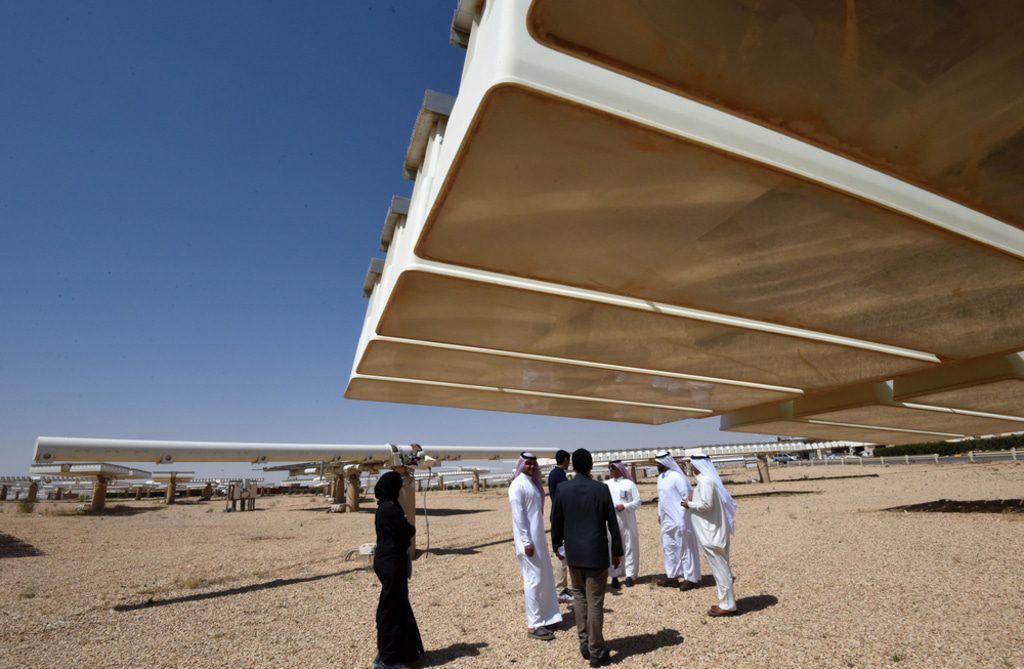
On 27 March 2018, the Japanese energy company SoftBank announced it was investing in the world’s biggest solar power project in Saudi Arabia. The project is expected to produce up to 200 gigawatts (GW) by 2030.
Saudi Arabia made investing in clean energy projects a goal back in 2012, when it announced its new economic plan, Vision 2030. “In 2012, the Saudi government unveiled plans to invest more than $100 billion in clean energy projects till 2030 in order to generate 41GW, a third of its power requirements, from renewable resources, primarily solar energy,” Salman Zafar, environmental expert and founder of the association EcoMENA, told Fanack Chronicle. “However, the government drastically scaled back the programme in January 2015 and set a more realistic renewable target of 14 per cent of current generating capacity, 9.5GW, by 2030.”
SoftBank will invest an estimated $200 billion needed to generate 200GW, including solar panels, battery storage and a manufacturing facility for panels in Saudi Arabia. The rest of the funding will come from project financing. For the first phase of 7.2GW of solar capacity, $5 billion is required, with $1 billion coming from SoftBank. The project will be launched this year and should start producing electricity by 2019. The final solar plant will cover an area of 5,000km2, the equivalent of a city the size of Paris or Chicago.
For now, Saudi Arabia has just one large solar plant under construction, the 0.3GW Sakaka project, awarded to local firm Acwa Power in February 2018 at a cost of $302 million. The plant will generate enough electricity to power around 40,000 homes. “All the big developers are watching Saudi,” said Jenny Chase, an analyst at Bloomberg New Energy Finance, a market research firm, to The New York Times at the time. “The country has made grand plans and pronouncements, but various bodies within it have failed to agree on the new way forward.” For Chase, the Acwa agreement is “the first step in creating what is widely expected to be a major market”.
The current peak power demand for the kingdom stands at around 75GW, which constitutes a very high per capita primary energy consumption. At almost 8 million tonnes of oil equivalent (Mtoe) in 2015, this is five times higher than the global average of around 1.5 Mtoe.
Primary energy is composed of coal, renewables, hydroelectricity, nuclear energy, natural gas and oil. In 2015, Saudi Arabia was the fourth-largest producer of global primary energy at 648.61 Mtoe, far behind China (2.50 thousand Mtoe) but ahead of India (2.50 thousand Mtoe). With the kingdom’s consumption increasing at the rate of 6 per cent per year, investment in renewable energy is necessary.
This massive plan is in line with the kingdom’s aspiration of becoming the leading exporter of solar energy in the Middle East. “Vision 2030 is expected to play a key role in realizing this objective,” Zafar said. “Under the King Salman Renewable Energy Initiative, the Saudi government is reviewing the legal and regulatory framework for private sector investment in order to encourage public-private partnerships and promote local manufacturing of solar panels.”
This will allow global energy companies to invest in the local market, with an increase of investment from both the government and private companies. The SoftBank project alone will bring the globally installed solar power capacity to 400GW, which is comparable to the world’s nuclear capacity of 390GW.
“Though current installed solar capacity in the kingdom is less than 100MW, the world’s leading solar energy companies are already active in the local market, mainly due to the promise and potential of the Saudi solar sector,” Zafar added. “It is expected that installed capacity will shoot up in the coming 5-10 years due to commissioning of planned projects, increased governmental support and corporate investment.”
This situation could attract new funding for a country struggling financially from low oil prices. In the first quarter of 2017, Saudi Arabia’s gross domestic product (GDP) decreased by 0.5 per cent compared to the same quarter in 2016, its first drop since 2009. Saudi Arabia introduced austerity measures to contain the crisis, which it eased in January 2018 out of fear of riots. A week after introducing a new 5 per cent sales tax on most goods and more than doubling gas prices, the government announced an annual bonus for all state employees, and a monthly allowance of 1,000 riyals ($266) for government employees for a year as well as a 10 per cent stipend increase for students, a bonus for soldiers and a tax break for first-time home buyers.
Despite its financial woes, Saudi Arabia remains an influential player in the MENA region, both politically and economically, despite an ongoing diplomatic spat with Qatar. “Due to its regional dominance, Saudi Arabia can play a vital role in the proliferation of solar energy in the entire Middle East,” Zafar said. “The Vision 2030 target suggests that the country will grow its renewable energy capacity in increments, taking advantage of future cost declines and efficiency improvements, while also leaving the door open for emerging technologies.”
Boasting hundreds of hours of sun per month, Saudi Arabia could gain economically, environmentally and technically from solar energy. However, in the uncertain economic and political years ahead, it remains to be seen whether the country is going to be able to realize its ambitions.


